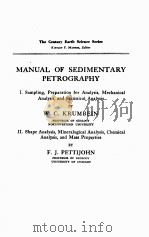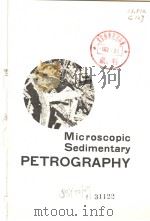《Petrography and Petrology》
| 作者 | Frank F.Grout 编者 |
|---|---|
| 出版 | The Brothers' Union Book Shop |
| 参考页数 | 524 |
| 出版时间 | 1932(求助前请核对) 目录预览 |
| ISBN号 | 无 — 求助条款 |
| PDF编号 | 813811848(仅供预览,未存储实际文件) |
| 求助格式 | 扫描PDF(若分多册发行,每次仅能受理1册) |

PART ⅠINTRODUCTION1
Nature of Criteria1
General Geology of Rocks3
Classification of Rocks4
Petrographic Methods and Minerals8
Prerequisite Methods8
Common Minerals9
Petrographic Problems11
1. To sample a rock outcrop11
2. To make a thin section12
3. To make a mechanical analysis of loose grains13
4. To separate the minerals of a rock powder14
5. To test a rock for minerals that give a silica jelly16
6. To make a chemical analysis of a rock17
7. To estimate the analysis of a rock by a microscopic examination17
8. Petrographic calculations18
9. To diagram the nature of rocks21
10. To illustrate a rock description22
11. To write a rock description22
Interpretative Petrography28
12. To interpret textures, mineral grouping and all the microscopic features of a rock in terms of rock history28
Allied Methods and Applications28
PART ⅡTHE PETROGRAPHY OF IGNEOUS ROCKS29
Field Schedule for Examining Igneous Rocks29
Main Minerals of Igneous Rocks30
Forms, Structures and Textures of Igneous Rocks31
Structures31
Textures40
Order of Crystallization44
Distinguishable Stages of Magmatic Action44
Development of the Classification of Igneous Rocks45
Nomenclature of Igneous Rocks49
Textural, Mineralogic and Special Varieties in the Several Clans52
Rhyolite-granite Clan53
Pegmatites and Aplites69
Trachite-syenite Clan73
Phonolite-nephelite syenite Clan79
Latite-monzonite Clan83
Andesite-diorite Clan85
Basalt-gabbro Clan90
Nephelinite-ijolite-missouritc Clan105
Perknite Clan106
Peridotite Clan108
Ores109
Meteorites111
Summaries of Certain Igneous Rocks113
The Glasses113
Volcanic Tuffs116
Igneous Breccias118
Abundance and Occurrence of Rock Types120
Dike Rocks in Classification121
Specific Gravities of Igneous Rocks125
Mineral Proportions in Igneous Clans125
Chemical Composition of Igneous Rocks126
Importance of Alkalies in Igneous Rocks128
Igneous Rock Series130
Historical Geology of Igneous Rocks138
Alterations of Igneous Rocks139
Economic Materials Related to Igneous Rocks140
PART ⅢTHE PETROLOGY OF IGNEOUS ROCKS143
Nature of Igneous Magma143
Generation of Magma143
Magmatic Heat144
Data and Theory as to the Inside of the Earth and Its Relation to Magmas148
Data Much Used in Petrologic Calculation148
Sources of Magma149
Geothermal Gradient149
Fusibilities and Fusion-pressure Curves152
Densities, Pressures and Compressibilities157
Strengths of Rocks163
Structures Indicating Deep Conditions172
Deeper Parts and Sources of Batholiths174
The Case for Zones or Shells in the Earth?178
Is There a Magma Zone in the Earth182
Summary of the Relation of Magmas to the Interior of the Earth184
Important Factors in Magma Generation187
Subcrustal Fusion and Fusion in the Crust187
Nature of "Primary Magma"190
Motion of Magmas193
Causes of Motion; the Forces Involved193
Modifying Factors195
How Magmas Move199
Cycles of Igneous Action207
The Moon's Igneous Rocks207
Physical Chemistry of Magmas208
States of Matter in Magmas and Related to Magmas208
Magmas Are Fundamentally Liquids209
Magmas Dissolve Gases210
Separation of Gases from Magmas213
Nature of Magmatic Emanations216
Sequence of Emanations220
Gases and Pegmatites220
Magmas Dissolve Liquids222
Magmas Dissolve Solids224
Assimilation225
Formations of Solids from Magma Liquids231
Equilibrium Diagrams234
The Reaction Principle242
Crystallization Stages in the Evolution of Magma245
Order of Crystallization246
Textures and the Equilibrium Diagrams247
Explanations for Rock Series248
Broad Provinces of the Earth as Series248
Explanations for Rock Series in Local Units248
Generation and Mixing248
Assimilation249
Differentiation249
Probability of Complex Origin of Series252
Conditions Favoring Differentiation253
Crystallization-differentiation and Special Cases254
Problems in Differentiation257
Recent Contributions and Summary258
PART ⅣTHE PETROGRAPHY OF SEDIMENTARY ROCKS260
General Features260
Relative Abundance of Sediments262
Methods for Sedimentary Petrography262
Classification of Sediments266
Sizes of Grain in Sediments268
Clays and Shales268
Sands and Other Mechanical Sediments (Not Clay and Limestone) _274
Limestones286
Miscellaneous Sedimentary Rocks202
Bedded Precipitates and Evaporites (Other Than Limestone)292
Concretions, O?lites, Nodules, Stalactites, Etc294
Veins204
Replacements295
Residual Rocks297
Organic Remains (Not Limestone)297
Mixed Sedimentary Rocks300
Summaries of Sediments301
Porosity and Specific Gravity301
Color of Sediments301
Composition302
Historical Geology of Sediments302
Mineral Association in Sediments303
Economic Materials and Sedimentary Rocks303
PART ⅤTHE PETROLOGY OF SEDIMENTARY ROCKS305
Sources of Materials305
Weathering305
Transportation of Sediments312
Mechanical Transportation312
Transportation in Solution317
Deposition of Sediments317
Mechanical Deposition317
Organic Deposition325
Chemical Deposition332
Equilibrium of Constituents in Sedimentation336
Diagenesis and Other Changes in Sediments336
Alternative Origins of Some Mineralogic Types of Sediments341
Sequences and Cycles of Sedimentation342
Interpretative Petrography of Sediments348
PART ⅥTHE PETROGRAPHY OF METAMORPHIC ROCKS350
General Features350
Methods for Metamorphic Petrography350
Metamorphic Structures and Textures351
Minerals of Metamorphic Rocks356
The Crvstalloblastic Series356
Classification of Metamorphic Rocks357
Gneisses358
Schists362
Argillites and Slates365
Quartzites366
Metamorphic Carbonate Rocks and Carbonate-silicate Rocks36
Contact Rocks370
Hydrothermal Rocks372
Weathered Rocks372
Summaries of Metamorphic Features372
Density and Composition372
Economic Interest in Metamorphic Rocks374
PART ⅦTHE PETROLOGY OF METAMORPHIC ROCKS375
General Features375
Evidences of Deformation376
Where and How Rocks Are Deformed378
Factors of Metamorphism379
Heat379
Pressures380
Chemical Affinity382
Crystal Forces382
Water383
Magma385
Gases386
Nature of the Rock386
Time387
Summary387
Structure and Growth of Crystals388
Strength of Crystalline Rocks389
Modes of Crystal Yielding390
Equilibrium391
Heat and Its Reaction Effects394
Concentration Reactions396
Pressure Reactions397
Processes of Metamorphism400
Rock Flowage401
Recrystallization404
Granulation412
Other Metamorphic Processes413
Plastic Deformation413
Introduction413
Subtraction414
Metasomatism or Replacement415
Convergence to Type in Metamorphism420
Kinds of Metamorphism421
Contact Metamorphism421
Regional Metamorphism424
Hydrothermal Metamorphism424
Summary of Common Metamorphic Changes427
Origin of a Metamorphic Rock431
Degrees of Metamorphism and Zones432
Metamorphic Zones around Igneous Intrusives433
Zones Related to Depth434
Zones of Hydrothermal Effects434
Cycles of Metamorphism434
General Features434
Normal Sequences of Geologic Events in Metamorphism437
Criteria of General Significance440
PART ⅧMINERAL TABLES AND READINGS443
Tables of Rock-forming Minerals443
Selected Readings479
INDEX505
1932《Petrography and Petrology》由于是年代较久的资料都绝版了,几乎不可能购买到实物。如果大家为了学习确实需要,可向博主求助其电子版PDF文件(由Frank F.Grout 1932 The Brothers' Union Book Shop 出版的版本) 。对合法合规的求助,我会当即受理并将下载地址发送给你。
高度相关资料
-

- SCIENTIFIC REPORTS Ⅲ-GEOLOGY-PETROLOGY VOLUMEⅠGEOLOGY AND PETROLOGY OF HARMPOSH-MANGO GUSOR AREA
- 1964 E.J.BRILL LEIDEN
-

- AN INTRODUCTION TO SEDIMENTARY PETROGRAPHY
- 1922 D. VAN NOSTRAND CO.
-
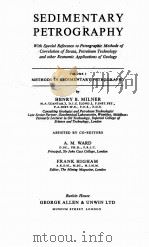
- SEDIMENTARY PETROGRAPHY VOLUME I
- 1962 GEORGE ALLEN AND UNWIN LTD.
-

- TRANSFORMISTS`PETROLOGY
- 1982 THEOPHRASTUS PUBLICATIONS S.A.
-
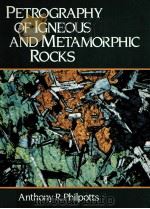
- Petrography of Igneous and Metamorphic Rocks
- 1988 Prentice Hall
-
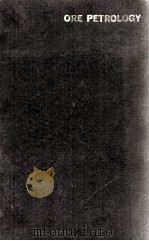
- ORE PETROLOGY
- 1972 McGRAW-HILL BOOK COMPANY
-
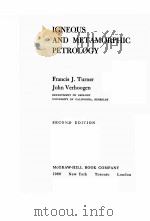
- IGNEOUS AND METAMORPHIC PETROLOGY SECOND EDITION
- 1960 MCGRAW-HILL BOOK COMPANY
-

- Progress in Metamorphic and Magmatic Petrology
- Cambridge University Press
-

- PRINCIPLES OF IGNEOUS AND METAMORPHIC PETROLOGY
- 1980 PRENTICE HALL
提示:百度云已更名为百度网盘(百度盘),天翼云盘、微盘下载地址……暂未提供。➥ PDF文字可复制化或转WORD


